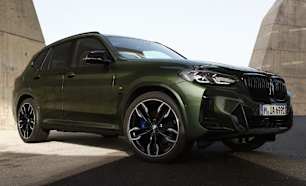The new X3 range kicks off with three distinct models. There’s the entry-level 20 xDrive at $86,100, the 30e xDrive at $104,100 and the big-hitting M50 xDrive at $128,900, all before on-road costs.
Both the 20 xDrive and the M50 xDrive feature a 48-volt mild hybrid driveline, while the 30e xDrive goes all the way with a plug-in hybrid (PHEV) layout. All variants also feature BMW’s permanent all-wheel-drive system.
BMW claims greater standard equipment than ever before, and even the entry-level 20 xDrive has plenty of kit including 19-inch alloy wheels, tri-zone climate-control, the virtual cockpit screens with a curved central info screen, a six-speaker, 100-Watt stereo, acoustic glass, auto headlights, an auto tailgate, keyless entry and start, digital radio, powered and heated front seats, wireless Apple CarPlay and Android Auto and wireless phone charging.
The PHEV model adds 20-inch alloys, the M Sport package including blue brake calipers, and a leather steering wheel, as well as the Comfort Package which adds heated seats for the second row of outer seats, a roller sun-blind for each rear-side window, ventilated seats, a heated steering wheel, tinted glass and a luggage net. The 30e also gets parking assistant, a panoramic sunroof (a non-opening one), and a surround camera system.
Move up to the M50 variant, and you’re in for no-cost metallic paint, 21-inch alloys, a 15-speaker stereo, quad exhaust tips, M-specific details such as the mirror caps and aero add-ons. You also get a range of kit as standard that comes as an extra-cost option on the other two variants. Those include the enhancement pack that includes an alarm system, surround sound, M Sport Pro Package (various trim highlights, red brake calipers, M seat belts) and the Comfort Package that is also standard on the 30e.
The value headline is that, compared with the previous model, some variants of the new car are actually cheaper on an apples-with-apples basis. The base model car in its previous form was, by the time you added the now-standard M Sport package, dearer at $88,100, and the previous 30e optioned to include the standard kit the new car has, (heated rear seat, acoustic glass, roller blinds and more) was also (much) more expensive at $111,800. And although the M50 model in its previous guise was slightly cheaper at $126,800, it lacked the hybrid driveline, metallic paint and M Sport Pro package the new car has as standard.

